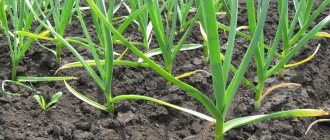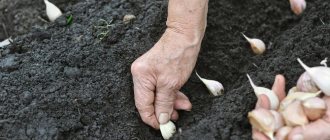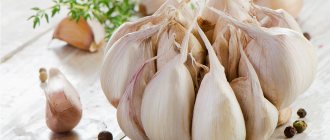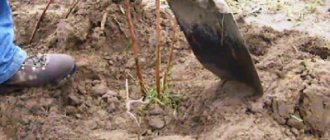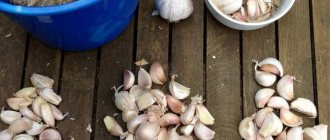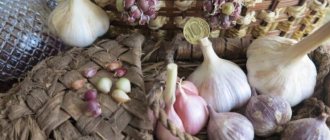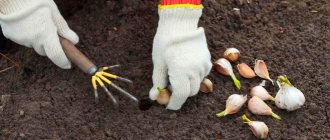In the fall, the time comes to plant winter garlic in the Moscow region.
The capital region has favorable conditions for growing this crop, so summer residents are sure to plant cloves. Dear readers!
For you, we have created communities on social networks in which useful articles and interesting ideas are published several times a day! Subscribe and receive useful content in a convenient format! In today's article we will talk about the timing and patterns of planting garlic.
What are the features of planting garlic in the fall in the Moscow region?
In the Moscow region, despite periodic harsh winters, the climate is quite favorable for growing garlic. Cloves planted in the fall overwinter well under cover and a layer of snow, and begin to grow in the spring.
However, there are some features of the procedure that need to be taken into account.
In general, the planting of cloves is planned for mid-October. According to ancient tradition, the procedure is carried out on Intercession Day.
This is done in order to be in time before real frosts.
ON A NOTE. If autumn is warm, then planting garlic in the Moscow region can be postponed to the end of October - beginning of November.
Winter in the Moscow region is not as severe as in the Urals or Siberia, but not as mild as in Kuban.
Therefore, the garlic still needs to be covered.
Experienced summer residents advise treating the teeth with a fungicide (for example, Fitosporin) or a weak solution of potassium permanganate before planting.
Be sure to consider crop rotation. Do not plant garlic after unfavorable crops. This will have the most negative impact on productivity.
Choose an area that is slightly raised above the surface. This will protect the garlic heads from melt water in the spring.
A very important factor is the quality of the soil. Before planting, the soil must be dug up and weeded. The acidity of the soil should be neutral. The ideal soil type is sandy loam.
Regarding the variety, you should still give preference to the zoned ones, but in general, almost all varieties of winter garlic grow well in the Moscow region.
Preparation of seed and soil
Winter varieties of garlic are propagated vegetatively by several types: bulb segments (cloves); single-toothed bulbs grown from aerial bulbs (sets); aerial bulbs (bulbs) in culture every other season. Spring varieties reproduce only by cloves (a bud with a growing point and leaf buds).
On a note!
It is not advisable to use store-bought garlic for planting. It is necessary to know the exact variety.
The seed is placed in a cool place with a temperature no higher than 5 °C for several weeks. Then the heads are carefully disassembled into slices and sorted. Only large cloves (about 3-4 centimeters) with a smooth surface are suitable for planting. Do not remove the clove scales. A head grown from a peeled segment will not be stored well.
Before planting, the selected material is disinfected with a solution:
- potassium permanganate (1%);
- copper sulfate (1%).
The cloves are placed in the solution for 30 minutes and then dried. If you use lye ash, about 2 hours should pass after immersion. Treatment with Fitosporin is acceptable. To speed up the germination of garlic, you can wrap the prepared cloves in a damp cloth and put them in a warm place for 2-3 days (it’s better to put them in a plastic bag). Central Asia is the birthplace of garlic, so winter varieties grow better on sandy loam soil. Spring varieties prefer medium and light loamy soils. A good place to plant cloves would be the beds in which the following grew last year:
- legumes;
- pumpkin;
- cabbage;
- cereal crops.
It is very useful to plant garlic in areas where forage grasses (alfalfa, sweet clover, clover) previously grew. It is not recommended to plant in beds after tomatoes or onions. You should avoid planting garlic after root crops. They greatly deplete the soil. It is not recommended to use the same area for planting garlic for several years in a row. It is better to use this area for sowing after 3-4 years.
Since garlic is a light-loving plant, it is best to plant it in sunny areas, well protected from strong gusts of wind. If you plant on a hill, you can avoid stagnation of water in the soil. A month before planting, the bed is dug to a depth of 20-25 centimeters. If you dig up the day before planting, the seed may go deep into the ground and die due to lack of air. Before planting, it is necessary to thoroughly clear the bed of weeds.
Favorable days for planting garlic in the fall in 2021 in the Moscow region
Among many summer residents in our country, it is customary to plant garlic cloves on the waxing moon.
In autumn, this phase of the moon will fall on the following dates:
- September 1, 18, 19, 20, 21, 22, 23, 24, 25, 26, 27, 28, 29, 30;
- October 1, 17, 18, 19, 20, 21, 22, 23, 24, 25, 26, 27, 28, 29, 30, 31.
- November 16, 17, 18, 19, 20, 21, 22, 23, 24, 25, 26, 27, 28, 29.
ON A NOTE. On Pokrov Day (October 14), the moon will be waning, but this day is also popularly considered favorable for planting garlic.
What weather should it be like when planting garlic in the Moscow region?
The average daily temperature in the Moscow region during garlic planting should be within +10 +12 degrees.
You can plant garlic cloves in any weather except heavy rain. Ideally, plant the vegetable after light rain.
The ground will just be wet.
If you plant in dry weather, do not forget to water the furrows for better rooting of the plant.
You should not carry out the procedure on a too cold or too warm day.
The temperature is +10 +12 due to the fact that these are ideal indicators at which the cloves will take root, but will not begin to “fatten” and grow feathers.
If it is colder, the planting material will not take root.
Boarding time
Winter garlic is planted in late autumn. This must be done before the slush and cold weather. Planting dates depend on the specific climatic conditions of the region; their range is mid-September to late October. In the southern regions, you can plant garlic even in November, but in the north it is better to complete the planting work earlier - in early autumn.
In order not to make a mistake with planting, be guided by the local climate. Find out when stable frosts occur on the ground. Garlic should be planted 3-4 weeks before this period. During the time remaining before frost, the planting material - cloves or bulbs - takes root, but does not germinate.
The gardener talks in detail about growing winter garlic in his video below:
What varieties of garlic are suitable for growing in the Moscow region
In general, in the Moscow region you can plant almost any winter garlic in the fall.
However, it is better to give preference to special zoned varieties. These are varieties of plants that were bred by breeders specifically taking into account the weather conditions of the Moscow region.
Nowadays the most popular varieties for the Moscow region are: Podmoskovny, Danilovsky local, Komsomolets, Gribovsky 60, Novosibirsky, Yuzhny Fioletovy, Nadezhny, Bryansky local, etc.
IMPORTANT! Carefully inspect the planting material. Rotten, wilted cloves, as well as damaged specimens, are not suitable for planting.
Planting material should be of medium size. Do not take too small and, conversely, large teeth.
ADVICE. Give preference to high-yielding varieties.
Buy planting material from trusted suppliers.
Popular varieties of winter garlic
To ensure a guaranteed good harvest, you need to use a variety of varieties.
Attention! It is important to purchase seed material in specialized stores. It is better to choose domestic varieties adapted to our regions.
The most popular varieties of winter garlic for autumn planting in the Central zone:
- Lyubasha garlic is a mid-season winter species, adapted to arid and cold regions, resistant to rot even at high humidity. Excellent storage for 10-11 months. The head is large, up to 6 cm in diameter. The shape is round, dense, the average weight of the onion is 90-150 g. The number of segments in the onion is 4-7.
- Sofievsky - a variety developed by breeders of the Uman Agrarian Academy 20 years ago. The peculiarity is that the species is winter-hardy, can withstand temperatures down to 30-40C and is at the same time resistant to drought (grown in regions with hot climates). The average weight of a large head is 100-150 g. Shelf life is up to 11 months.
- Komsomolets is a mid-season variety developed by the Voronezh Vegetable Station back in the 70s. last century. Gives good results even on barren and impoverished soils. From 1 sq. m on average, 1.2-1.5 kg are collected. The head is rounded-flat, dense, consists of 8-10 lobes. Bulb weight – 30-50 g. The variety is winter-hardy, plantings do not freeze out even in the northern regions, the variety is resistant to diseases.
- Podmoskovny is a bolting winter variety of garlic from the Moscow agricultural company Russian Seeds. Fully ripens in 100-110 days, mid-season appearance. The head is rounded-flat, compact, quite large - up to 60 g. Number of teeth - up to 5-7 pcs. The flesh is sharp, creamy in color. The yield is high - more than 1.5-1.7 kg per 1 sq. m. Under optimal conditions, it is stored for 60-70 days, retaining taste up to 95%.
- Alcor is a domestic mid-season variety of bolting type, ripens in 90 days. Adapted to the temperate climate zone, tolerates winter well in Siberia. The average weight of the dense compact head is 30-35 g, the teeth are elongated, 4-5 pieces. The yield is average - up to 500 g per 1 sq. m. The variety is updated with aerial bulbs.
How to choose the right place to plant winter garlic
Choosing a place to plant garlic in the fall depends on several aspects:
- The place should be well ventilated and lit.
- There should be shelter from the north from the cold wind (for example, from bushes, a fence or an outbuilding).
- The bed should be slightly raised above ground level. This way, melt water will not accumulate in the hollow, and the bulbs will not rot.
- The selected area must have a suitable type of soil of neutral acidity (chernozem, sandy loam).
- The bed must be dug at least 20 cm deep.
- All debris from the garden must be removed.
- The land must be fertilized with a complex composition of organic matter and mineral fertilizer.
Then you can and cannot plant garlic in the fall
Crop rotation is an agricultural achievement that many summer residents look down on.
However, it has long been proven that proper rotation of crops in the same area has a positive effect on productivity.
In the table below we have collected information about acceptable and unacceptable precursors for garlic.
| Valid predecessors | Invalid predecessors |
| cucumbers | oats |
| peas | garlic |
| zucchini | beet |
| buckwheat | greenery |
| beans | Spices |
| pumpkins | onion |
| clover | potato |
| mustard | barley |
Effective garlic planting schemes
Now let's talk directly about planting garlic in the soil.
Use the tape method or the square-cluster method. They differ in that with the tape type, several parallel grooves are dug, and with the square-cluster type, separate planting holes are dug.
The most common method, of course, is the strip planting method.
The procedure begins about a month before the expected planting of the cloves.
At this time, the bed is dug up and weeded.
A mixture of organic and mineral fertilizer is added during digging.
Since garlic does not need nitrogen in the fall, the main attention is paid to saturating the soil with potassium and phosphorus.
The most popular mixture is prepared from compost or humus (10 kg), superphosphate (30 g) and potassium salt (30 g). This is per 1 square meter of garlic beds.
The landing itself is very simple.
Step 1. Make grooves or planting holes. Depth – 10 cm. If the planting material is not very large, then 8 cm is allowed.
Step 2. If the soil is dry, then moisten it and let the water absorb.
Step 3. Plant the cloves, lightly pressing them into the ground. Place bottom down, arrow pointing up. Don't get confused!
Step 4. Cover with soil and compact lightly.
Step 5. Water from a watering can.
Step 6. Mulch with sawdust or cover with agrofibre.
Step 7. Cover with dry grass and leaves. In general, if the temperature does not drop for a long time, then you can cover it a little later. But we advise you to make a shelter right away so as not to miss the moment later.
Planting and caring for winter garlic
At what depth and how to plant garlic correctly?
There is often confusion about planting depth. The optimal depth is calculated according to the rule - the height of the clove itself + 5 cm from above. On average, the recommended value is from 6 to 8 cm. At this planting depth in the spring, garlic sprouts very quickly. But in winter conditions with little snow, it can freeze. Therefore, in areas with little snowy winters and northern regions, it is better to plant deeper.
How to properly plant and care for garlic
The teeth are planted in specially prepared grooves. Their depth is 15-20 cm, the width between them is about 25 cm. The bottom is covered with a layer of coarse river sand (about 2-3 cm) so that the cloves do not touch the ground and do not rot. We plant the teeth so that the bottom is at the bottom. This will allow the root system to quickly begin to form.
The distance between rows is 8-15 cm, depending on the size of the planting material. If the soil is dry, you can spill it with a pink solution of potassium permanganate. To protect plantings from excess moisture and at the same time from severe freezing, it is advisable to mulch the soil with a layer of humus or leaves.
To protect against cold weather, you can put roofing felt on top. Garlic leaves before winter in exactly this form. After this, care for the beds will be carried out in the spring.
At what depth and distance is it advisable to plant garlic?
The choice of planting depth and pitch is very important.
If the cloves are planted too deep, the bulbs will not develop well and will be small.
On the contrary, if planted too close to the surface, the cloves may die from frost.
The distance between plants is also important. Planting too often will cause the vegetables to lack sun and nutrients. This will affect the harvest.
Planting too sparsely will complicate plant care. You will have to do a lot of weeding and the water consumption will increase.
The optimal planting depth for garlic cloves in the fall in the Moscow region is 10-12 cm.
The optimal distance between plants is 15 cm. You can do more if you plant a large-fruited variety.
Care and cultivation
Caring for winter garlic begins in early spring and lasts until harvesting. In the northern regions, garlic ripens in the last ten days of July, in others - earlier.
in spring
Caring for winter garlic in spring:
- As soon as the snow melts, the spruce branches or branches, if they were used as shelter, are removed. And there is no need to remove the layer of fine mulch and organic matter - soon green sprouts will appear from under it. Winter garlic is the first green in the garden. Sprouts emerge in March-April.
- When the greens appear, the garlic is fertilized with nitrogen. Two weeks after emergence, the plantings are watered with a solution of urea, ammonium nitrate or nitroammophos (per 10 l - 20 g). After 2 weeks - re-feeding.
- During the growing season, the beds are regularly weeded and loosened to a depth of 3 cm.
- Water the plantings every 5-7 days.
In summer
Caring for winter garlic continues in the summer:
- In June, a third feeding is carried out to support the plants during the formation of heads. Phosphorus and potassium are added by watering the beds with an ash solution. It is prepared by steeping a glass of ash in a bucket of water for three days. You can also add a solution of potassium monophosphate (per 10 l - 20 g), superphosphate (per 10 l - 25 g) or potassium nitrate (per 10 l - 15 g).
- Garlic plantations continue to be watered in summer with the same frequency as in spring. In hot weather, the frequency of watering increases. Three weeks before harvesting, watering is stopped.
- After each watering, it is advisable to loosen the soil.
- When the arrows reach 15 cm in length - for arrowing varieties of garlic - they are broken out. This is necessary to prevent the waste of nutrients on peduncles.
Caring for garlic after planting in the Moscow region, preparing for winter
Planting garlic in the fall leaves some imprint on the further care of the crop.
There is a cold winter ahead, which means that the planted cloves must be protected from frost.
To do this, cover the garlic bed.
First you need to mulch. Dry grass or sawdust will do. Can be covered with agrofibre.
Next comes the main shelter. Dry leaves, spruce branches, dry grass, hay, etc. are used for it.
In winter there will still be a layer of snow.
This whole structure is designed to protect the garlic during the winter.
No further care is needed until spring.
Common mistakes
Despite the fact that planting garlic in the fall is a fairly simple undertaking, novice gardeners can make some mistakes.
Let's sort them out.
- Poor quality planting material. Make sure there is no rot. Sluggish and soft teeth are also not suitable. Take medium-sized specimens without rot or damage.
- Planting garlic too early. If autumn is not very cold, then do not rush to plant garlic. Remember that the ancestors always landed on the Intercession.
- Planting cloves in frozen ground. But there is no need to delay landing. Garlic will not take root in frozen soil, and you will not get any harvest next summer.
- The bed is not watered after planting. When you have covered the cloves, water them with a watering can. If rain is forecast, you don't have to water.
- No shelter is being made. Don't burn all the grass in your garden. Leave a little to create a shelter. Also don't forget about mulching!
- The distance between the teeth is too small. Because of this, the harvest is small. Taste also suffers.
- Use of fertilizers containing large quantities of nitrogen. They start to grow arrows, and this is not necessary in the fall.
- Wrong choice of planting depth. 10-12 cm is the optimal depth. Deeper - the garlic bulbs will be small. Closer to the surface they will freeze.
Further care of the beds
Autumn plant care does not require complex rules. In the spring, after green shoots begin to appear, it is necessary to inspect the area and remove unsprouted cloves.
Cultivation care
For rapid growth, it is important to fertilize the soil in a timely manner. For these purposes, bird droppings can be used, which are diluted in water in the proportion of 1 kg of substance per bucket of water.
It is also necessary to loosen the soil at least 2 times a month, thereby saturating it with oxygen and facilitating the penetration of moisture to the roots.
In the spring, if there is no precipitation, it is necessary to provide the crop with a sufficient amount of moisture. To do this, water the garlic rows at the root.
When shoots appear, it is recommended to remove them, since additional shoots take away nutrients, slow down the growth of the plant and lead to the heads becoming smaller.
Garlic is practically not susceptible to disease, but for prevention it is necessary to dust it with ash. This effect saturates the soil with useful components and reduces the risk of pests.
Is it necessary to cover garlic for the winter in the Moscow region?
Temperatures change quickly in this region, so covering the area is necessary. However, in early spring you should get rid of the shelter. This will not only speed up the sprouting process, but will also prevent the risk of mold.
Garlic shelter in the Moscow region
How to do it right
Covering the beds should begin a few weeks after planting. This procedure is carried out again after the temperature drops, with the onset of the first frosts. Humus mixed with leaves is used as a protective layer. The mixture is laid in an even layer and covered with roofing felt on top. This insulation prevents the risk of tooth damage.
Straw or sawdust can also serve as shelter. Despite the fact that the crop is considered unpretentious, during severe frosts the beds can be damaged, as a result of which seedlings will not appear in the spring.
Growing crops in the Moscow region requires following some recommendations. Despite the fact that the crop is immune to cold and disease, it is necessary to cover the beds in a timely manner.
It is also important to initially select the optimal variety and follow the rules for disinfecting planting material: this will not only speed up the process of shoots appearing in the spring, but will also prevent infection with diseases.
Answers to frequently asked questions
What folk signs are there?
People say that they plant garlic when their hands are cold and the birds fly south. In Central Russia they have long been planted on Pokrov.
Where can I get cloves for planting?
You can actually buy it at a hardware store. Or cut a regular head of garlic into cloves.
How to prepare garlic for planting in the fall?
It is recommended to treat teeth with a solution of potassium permanganate.
Do I need to remove the husks from the clove before planting in the fall?
No no need. Planting is carried out in the husk.
What fertilizers should I put before planting?
Precisely in a groove or hole - none. Fertilizers are applied 30-40 days before planting.
Does it make a difference which variety to choose for the Moscow region?
By and large, only varieties zoned for the southern regions are not suitable. And this way you can even plant varieties for Siberia.
How to prepare garlic for planting in the fall
Garlic is a popular food plant. According to its biological characteristics, it is a herbaceous perennial, a species representative of the Onion genus, and belongs to the huge Amaryllis family (Onion subfamily).
This is interesting. Florist and researcher of Central Asia Vvedensky A.I. claims that the forefather of garlic is the long-pointed onion. The first varieties of the culture were discovered in the mountains of Turkmenistan, Tajikistan and the Tien Shan mountains. In Egypt, Ancient Greece and Rome, the spice began to be cultivated in the 6th century. BC e.
How to treat garlic before planting before winter? In general, growing garlic does not require Herculean efforts and material costs. But culture has characteristics and preferences.
Differences between spring garlic and winter garlic
Both garlic can be planted in both autumn and spring. However, they are different.
Winter garlic has fewer cloves, but they are larger in size than spring garlic. It shoots, but stores well until spring.
Spring garlic has more cloves, but they are smaller in size. It does not shoot, is suitable for pickling and processing, but it is not stored in winter.
First – preparation and selection of seeds
Rules for preparing garlic seeds (cloves) for planting in the fall:
- The largest cloves in the head are selected for seeds, according to the varietal variety (a large clove yields a harvest of a large onion);
- small slices are planted, as a rule, for seeds;
- disassemble the bulb into slices no later than 2 days before planting;
- carefully remove the scales from each slice with a knife (thrips “live” behind the protective scales); some gardeners do not remove the covering scales;
- to facilitate the procedure, the heads are pre-soaked in water for 1-2 hours;
- Initially, the teeth should be smooth, clean, without damage, dents, stains or signs of rotting;
- for 1-5 days, the seed is placed in a disinfecting solution;
- The processing (soaking) procedure is carried out at room temperature, the containers are placed in a shaded room.
The second rule is disinfection procedures
To disinfect planting segments from fusarium (the main danger of the crop), gray rot, and aspergillus fungal mold, solutions of special protective agents for treating garlic before autumn planting:
- Phytosporin or Bactogen (analog drug) - bacterial agents populate competitive microflora, completely cleans garlic cloves; not dangerous for plants and soil microflora; lasts for a long time, until spring;
- Pharmaiod - a fungicide is used when there is a high level of contamination of seeds and soil; the drug is toxic. Just like hydrogen peroxide and brilliant green, it has an adverse effect on soil microflora;
- Zelenka (brilliant green) - a weak solution is ineffective; for disinfection, use a concentrated mixture in a 1:1 ratio or soak the slices with a primary solution;
- Hydrogen peroxide 3% - quickly decomposes in the soil, the treatment is effective, but the solution disrupts the function of soil bacteria;
- The drug Maxim XL (protectant) and Chlorhexidine (antiseptic) are powerful agents used for obvious contamination of soil and planting bulbs; have an average level of phytotoxicity, it is not recommended to abuse “heavy” chemicals;
- Phytoflavin for plants (from fungi and rot) - the product is non-toxic for plants, but copes satisfactorily with severe fungal infections, and is used to prevent healthy teeth;
- Epin extra (growth stimulator with a protective function) - the solution is not suitable for eradicating gray rot; long-acting hormonal drug, beneficial accelerator substances are released gradually, a quick effect is unlikely;
- Trichodermin, Trichovit (Trichoderma) is an extra-class biofungicide that destroys specific spores of plant fungi; minus - quickly destroys the protective shell (skin) of the planting teeth; accelerated decomposition of the peel provokes damage to the clove by harmful insects (for example, wireworms);
- Folk remedies for treating garlic before planting are an alcohol solution of turmeric (5 g per 100 ml of alcohol), a solution with the addition of thyme essential oil.

